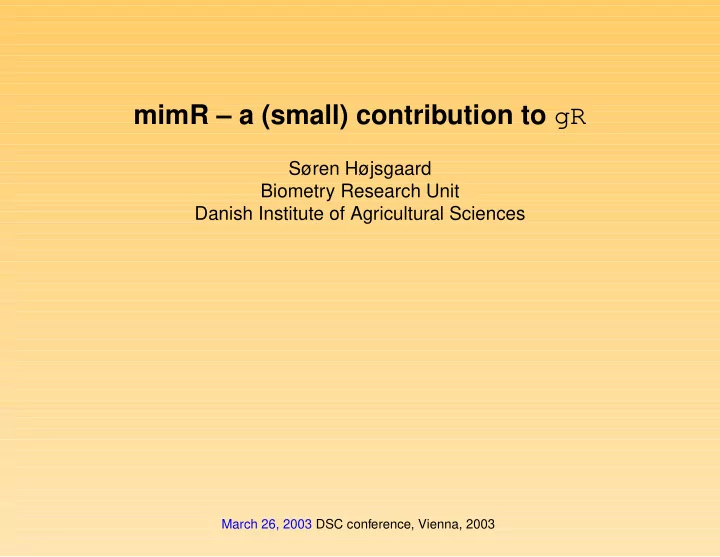

mimR – a (small) contribution to gR Søren Højsgaard Biometry Research Unit Danish Institute of Agricultural Sciences March 26, 2003 DSC conference, Vienna, 2003
1 mimR – graphical models in R • MIM ( www.hypergraph.dk ) is a general (and unique) package for statistical inference (model fitting, model selection etc.) in M ixed I nteraction M odels – a large class of “graphical” models (where conditional independence restrictions are of interest). • R is a general statistical package and programming environment. • mimR integrates the functionality of MIM into R . mimR is available as an R package. For additional information, see http://www.jbs.agrsci.dk/~sorenh/mimR/ March 26, 2003 DSC conference, Vienna, 2003
2 Outline of presentation • Why mimR ?? 1. In 2000, needed to access MIM from Splus 2. In 2002, the gR–workshop lead to a proper R package • Why the name mimR ?? • Technicalities: Accessing MIM from R • Primitive use of mimR • The object structure of mimR : ◮ mimData ◮ mimModel • The future of mimR • Example March 26, 2003 DSC conference, Vienna, 2003
3 Technicalities: Accessing MIM from R Think of MIM as the “inference engine” accessed from R : ✲ ✲ R MIMTerm mimR 1.0 MIM ✛ ✛ ✲ R sockets MIM mimR 1.01 ✛ ✲ R ???? "MIM" mimR 1.0? ✛ Presumably not the most elegant way one can think of – but it works... March 26, 2003 DSC conference, Vienna, 2003
4 MIM Models – very briefly Discrete variables d , continuous variables y . Model: p ( d, y ) = p ( d ) p ( y | d ) where • p ( d ; θ ) : Log–linear model • p ( y | d ) = N ( µ d , Σ d ) Structure of models arise by imposing constraints on ( θ, µ d , Σ d ) . The syntax for a MIM model d 1 , d 2 , . . . , d p /l 1 , l 2 , . . . , d q /q 1 , q 2 , . . . , q r refering to the d iscrete, l inear and q uadratic generators. March 26, 2003 DSC conference, Vienna, 2003
5 “Primitive” use of mimR 1. Direct access to MIM via mim.cmd –function, e.g. mim.cmd("input d:\mathmark.dat; model //xyz,xzu; fit;") which returns whatever the last MIM command returns. 2. mimR has a collection of functions mimicing corresponding MIM functions but interprets the output in appropriate ways (creates data structures with the output): mimR function MIM command mim.stepwise stepwise mim.testdelete testdelete mim.print print mim.display display mim.fit fit mim.emfit emfit March 26, 2003 DSC conference, Vienna, 2003
6 mimR is object–oriented • Variable names in MIM are 1–character, “a”, “b”,...., which is an inconvenient restriction... • To circumvene this restriction, a mechanism for mapping dataframe–names to MIM –names (and vice versa) was established by means of mimData – objects. • From thereof the road was paved for creating mimModel –objects etc. such that (at least in principle) the user needs not be concerned with that model fitting, model selection etc. takes place in MIM . March 26, 2003 DSC conference, Vienna, 2003
7 mimData –objects A data frame in R is turned into a mimData –object, which can be submitted to MIM : md <- as.mimData(data=...) submit(md) mimR keeps track of that md is the current MIM data set (the data set currently loaded into MIM ). (There can be at most one current data set at the time). md is an object of class mimData to which certain methods are associated. To a mimData object several mimModel objects can be associated. mimData mimModel mimModel mimFormula mimModel fittedValues ......... parameterEstimates mimBRModel MIM mimBRModel March 26, 2003 DSC conference, Vienna, 2003
8 mimModel –objects A mimModel –object consists of • A mimFormula –object (where the model formula follows MIM syntax). • A (reference to) a corresponding mimData object. • Summary statistics (currently, deviance and DF). • Slot is.current (there can be at most one current model at the time) mm <- mim.model( mim-formula, data=...) March 26, 2003 DSC conference, Vienna, 2003
9 The future (if any) of mimR mimR will hopefully be obsolete in a not too distant future – not because graphical modelling in R is not relevant, but because a more coherent approach to graphical modelling in R is needed. – That is the aim of the gR–project. Until that happens, proceed at slow pace: • Move functionality from MIM to R • Create graph modules • .... March 26, 2003 DSC conference, Vienna, 2003
10 Example library(mimR) data(carcass) md <- as.mimData(carcass) submit.mimData(md) mm1 <- mim.model("//F11:M11:F12:M12:F13:M13,LMP", data=md) mm2 <- stepwise(mm1,"f") mm3 <- stepwise(mm2,"ub") mp <- mim.print("i") d1 <- display(mm2, "LMP", c("F11:M11:F12:M12:F13:M13")) d2 <- display(mm2, c("LMP","F11"), c("M11:F12:M12:F13:M13")) d3 <- display(mm2, c("LMP","F11")) carcass2 <- carcass carcass2[,"L"] <- rnorm(nrow(carcass2)) md2 <- as.mimData(carcass2) submit.mimData(md2) March 26, 2003 DSC conference, Vienna, 2003
11 mm4 <- mim.model("//L:F11,L:M11,L:F12,L:M12,L:F13,L:M13,L:LMP", data=md2, fit=F) namesTable(md2) mim.cmd("calc h=ln(0)") mim.emfit(plot=T) d4 <- display(mm4, "LMP", c("F11:M11:F12:M12:F13:M13")) data(rats) m.rats <- as.mimData(rats) mm1 <- mim.model("Sex, Drug/Sex:W1,Drug:W1,\ Sex:W2,Drug:W2/Sex:W1:W2,Drug:W1:W2", data=m.rats) mm2 <- stepwise(mm1) March 26, 2003 DSC conference, Vienna, 2003
Recommend
More recommend